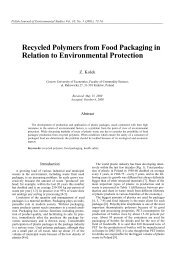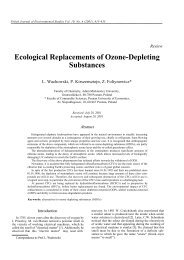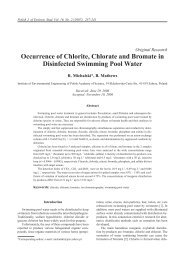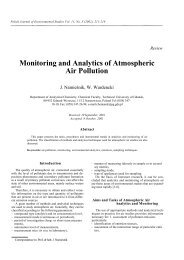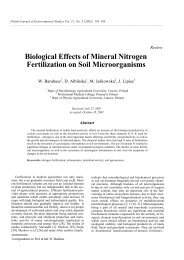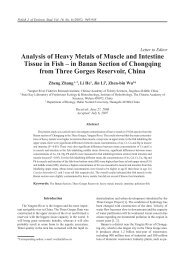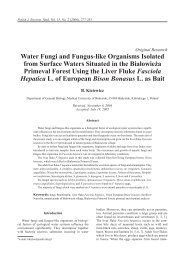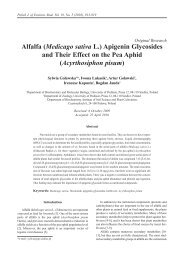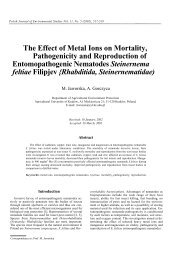Oxidation of Pyrite and Marcasite by Thiobacillus ferrooxidans Bacteria
Oxidation of Pyrite and Marcasite by Thiobacillus ferrooxidans Bacteria
Oxidation of Pyrite and Marcasite by Thiobacillus ferrooxidans Bacteria
Create successful ePaper yourself
Turn your PDF publications into a flip-book with our unique Google optimized e-Paper software.
Polish Journal <strong>of</strong> Environmental Studies Vol. 9, No. 2 (2000), 87-90<br />
<strong>Oxidation</strong> <strong>of</strong> <strong>Pyrite</strong> <strong>and</strong> <strong>Marcasite</strong> <strong>by</strong><br />
<strong>Thiobacillus</strong> <strong>ferrooxidans</strong> <strong>Bacteria</strong><br />
K. Nowaczyk, F. Domka<br />
Department <strong>of</strong> Kinetics <strong>and</strong> Catalysis, Faculty <strong>of</strong> Chemistry, Adam Mickiewicz<br />
University, 60-780 Poznan, ul. Grunwaldzka 6, Pol<strong>and</strong><br />
Received 28 June, 1999<br />
Accepted 23 July, 1999<br />
Abstract<br />
This paper reports results <strong>of</strong> studies on the influence <strong>of</strong> the crystallographic mineral structure on the<br />
process <strong>of</strong> pyrite <strong>and</strong> marcasite leaching.<br />
Kinetic studies show that the crystallographic structure <strong>of</strong> minerals like FeS 2 type does not influence the<br />
efficiency <strong>of</strong> the process.<br />
Keywords: <strong>Thiobacillus</strong> <strong>ferrooxidans</strong>, pyrite, marcasite, bioleaching<br />
Introduction<br />
The process <strong>of</strong> metal leaching from ores with the help<br />
<strong>of</strong> bacteria depends on many physical, chemical <strong>and</strong> biological<br />
factors [1]. Its efficiency is affected <strong>by</strong> environmental<br />
conditions but also on bacteria activity <strong>and</strong> the<br />
structure <strong>of</strong> metal-bearing minerals. According to one<br />
approach explaining the role <strong>of</strong> bacteria in the process <strong>of</strong><br />
metal leaching, the mineral molecules with the adsorbed<br />
bacteria cells form an electrochemical system in which<br />
the electrons from the cathode surface <strong>of</strong> the mineral<br />
move to the final electron acceptor being the atmospheric<br />
oxygen [2]. The adsorption <strong>of</strong> bacteria on the<br />
metal surface is possible thanks to organic polymers produced<br />
<strong>by</strong> their cells [3]. The adsorption sites are first <strong>of</strong><br />
all cation deficits, which are also the sites <strong>of</strong> occurrence<br />
<strong>of</strong> elemental sulphur, which is dissolved in phospholipides<br />
<strong>of</strong> the cell membrane <strong>and</strong> then transported inside the<br />
cell (following the concentration gradient) <strong>and</strong> enzymatically<br />
oxidized to sulphates. At the sites from which sulphur<br />
was washed out, secondary cation deficits appear<br />
stimulating diffusion <strong>of</strong> sulphur from deeper layers <strong>of</strong> the<br />
mineral crystal lattice onto the mineral surface where it is<br />
subjected to another attack <strong>of</strong> bacteria. The process can<br />
be illustrated as beside.<br />
Biooxidation leads to the formation <strong>of</strong> sulfuric acid,<br />
which initiates subsequent stages <strong>of</strong> the process involving<br />
iron ions (II), which after oxidation to iron (II) ions are<br />
responsible for chemical oxidation <strong>of</strong> sulphides [4]. As<br />
yet the mechanism <strong>of</strong> metal bioextraction has not been<br />
unambiguously determined; some authors concentrate<br />
on the direct process involving microorganisms [5], while<br />
others consider mainly the chemical (indirect) mechanism<br />
[6]. Recent works <strong>by</strong> Schippers et al. [7] prove that<br />
the process is dominated <strong>by</strong> the chemical mechanism. As<br />
follows from their results, pyrite oxidation <strong>by</strong> iron ions
88<br />
Nowaczyk K., Domka F.<br />
(Ill) in the absence <strong>of</strong> bacteria (only chemical leaching is<br />
observed), leads to the formation <strong>of</strong> sulphates according<br />
to the mechanism involving thiosulphate formation. The<br />
same products were obtained with the use <strong>of</strong> the T. <strong>ferrooxidans</strong><br />
bacteria, which suggests that the role <strong>of</strong> bacteria<br />
is to maintain a desired concentration <strong>of</strong> iron ions<br />
<strong>and</strong> the mechanism <strong>of</strong> metal leaching can be depicted as<br />
follows:<br />
It was also found that the crystallographic form <strong>of</strong> the<br />
minerals influences the kind <strong>of</strong> products formed as a result<br />
<strong>of</strong> microbiological oxidation [8], so it must also affect<br />
the mechanisms <strong>of</strong> the processes. The sulphides insoluble<br />
in acids (FeS 2 , MoS 2 , WS 2 ) are susceptible for the oxidation<br />
attack <strong>of</strong> iron ions (III), which leads to the formation<br />
<strong>of</strong> thiosulphides as the main intermediate products oxidized<br />
further according to the scheme:<br />
FeS 2 + 6 Fe 3+ + 3 H 2 O -> S 2 O 3 2 - + 7 Fe 2+ + 6 H +<br />
S 2 O 3 2 - + 8 Fe 3+ + 5 H 2 O -> 2 SO 4 2 - + 8 Fe 2+ + 10 H +<br />
The iron (II) ions are oxidized <strong>by</strong> the bacteria:<br />
As follows from the above, mineral leaching may occur<br />
mainly <strong>by</strong> chemical processes, <strong>and</strong> the role <strong>of</strong> bacteria<br />
is reduced to<br />
(i) production <strong>of</strong> biogenic sulfuric acid used for the<br />
hydrolytic attack (if a given mineral is susceptible for it)<br />
<strong>and</strong> to<br />
(ii) maintaining iron ions (III) in the oxidized form<br />
(Fe 3+ ) ready for the oxidation attack.<br />
The same conclusions were drawn <strong>by</strong> T.A.Flower et al.<br />
[6], who reported that leaching <strong>of</strong> ZnS in the presence <strong>of</strong><br />
bacteria as well as in the sterile samples, in the conditions<br />
<strong>of</strong> a constant redox potential (constant concentration <strong>of</strong><br />
iron (II) <strong>and</strong> iron (II) ions) gives the same products.<br />
This paper reports results <strong>of</strong> study on the influence <strong>of</strong><br />
the crystal structure <strong>of</strong> minerals on the efficiency <strong>of</strong> bacteria-aided<br />
metal leaching. The minerals chosen were<br />
chemically identical iron sulfides: pyrite <strong>of</strong> the regular<br />
structure <strong>and</strong> marcasite <strong>of</strong> the rhombohedral structure.<br />
Fig. 2. Powder dyfractogram <strong>of</strong> marcasite (A - examinated,<br />
B - st<strong>and</strong>ard).<br />
Materials <strong>and</strong> Methods<br />
The <strong>Thiobacillus</strong> <strong>ferrooxidans</strong> bacteria were isolated<br />
from the mine waters from the Siersza colliery. St<strong>and</strong>ard<br />
growth was conducted on Silverman 9K medium in 50 ml<br />
Erlenmayer flasks kept in thermostated shakers. The<br />
process was run at 37°C at the initial pH <strong>of</strong> the medium<br />
<strong>of</strong> 2.20. The inoculum made 10% (wt/vol). Experiments<br />
were performed for the chemically identical iron sulphides<br />
(FeS 2 ) pyrite <strong>and</strong> marcasite. Their chemical composition<br />
was established from quantitative analyses - pyrite<br />
contained 46.5% Fe <strong>and</strong> 53.4% S, while marcasite<br />
45.9% Fe <strong>and</strong> 53.5% S.
<strong>Oxidation</strong> <strong>of</strong> <strong>Pyrite</strong> ...<br />
89<br />
cal leaching) were inoculated <strong>by</strong> boiled inoculum <strong>and</strong><br />
moreover to each reactor 1500 ppm <strong>of</strong> Hgl 2 , as a bacteriostatic<br />
agent, was added.<br />
The kinetic data were processed <strong>by</strong> the program<br />
Scientist for Windows. The fit <strong>of</strong> the model curves to<br />
experimental data was performed <strong>by</strong> linear regression using<br />
the least square method.<br />
Results <strong>and</strong> Discussion<br />
The Kinetic Model<br />
The process was best described <strong>by</strong> the first order reaction<br />
against the substrate, inhibited <strong>by</strong> the product Fe 3+ ,<br />
the sum <strong>of</strong> the squares <strong>of</strong> deviations did not exceed 0.02,<br />
<strong>and</strong> the correlation coefficient was 0.998 in almost all<br />
cases. The reaction could be described <strong>by</strong> the following<br />
equation:<br />
Fig. 3. The effect <strong>of</strong> pyrite content in the medium [%] on the<br />
yield <strong>of</strong> iron leaching (temp. 37°C, pH - 2.2, mineral grain size<br />
below 0.125 mm, ch - chemical leaching).<br />
Fig. 4. The effect <strong>of</strong> marcasite content in the medium [%] on the<br />
where:<br />
x o <strong>and</strong> x - are the initial <strong>and</strong> current concentration <strong>of</strong> the<br />
substrate,<br />
k 1 - is the rate constant <strong>of</strong> leaching,<br />
k 2 - the rate constant <strong>of</strong> inhibition,<br />
t o - induction period,<br />
t - time.<br />
The parameters found from this equation were: ki, k 2<br />
<strong>and</strong> t o .<br />
yield <strong>of</strong> iron leaching (temp. 37°C, pH - 2.2, mineral grain size<br />
below 0.125 mm, ch - chemical leaching).<br />
The crystalline structure <strong>of</strong> the minerals was determined<br />
on the basis <strong>of</strong> X-ray diffraction measurements <strong>by</strong><br />
the powder method for the angles 2-30 Θ. The concentration<br />
<strong>of</strong> iron (III) ions was measured <strong>by</strong> the rhodanate<br />
method [9] on a Beckman DU 640 spectrophotometer.<br />
The process <strong>of</strong> the mineral leaching was run in 350 ml<br />
Erlenmayer flasks containing iron-free Silverman medium<br />
with 10% <strong>of</strong> the inoculum <strong>and</strong> 1.2 <strong>and</strong> 3% (wt/vol)<br />
<strong>of</strong> pyrite or marcasite. The process was monitored <strong>by</strong><br />
measurements <strong>of</strong> changes in the concentration <strong>of</strong> iron<br />
(III) ions in the solution. The reference samples (chemi-<br />
As follows from the kinetic curves <strong>of</strong> pyrite <strong>and</strong> marcasite<br />
oxidation <strong>by</strong> <strong>Thiobacillus</strong> <strong>ferrooxidans</strong> bacteria, the<br />
processes <strong>of</strong> inhibition take place during leaching (Figs.<br />
3 <strong>and</strong> 4). With increasing concentrations <strong>of</strong> the mineral<br />
in the system the rate constant <strong>of</strong> the reaction decreases<br />
while the rate <strong>of</strong> inhibition increases. The efficiency <strong>of</strong><br />
the iron extraction decreased also with an increasing<br />
amount <strong>of</strong> the mineral in the substrate.<br />
A comparison <strong>of</strong> the kinetic curves <strong>of</strong> marcasite <strong>and</strong><br />
pyrite leaching shows that the rate <strong>of</strong> pyrite oxidation is<br />
greater (Table 1). The increase <strong>of</strong> the percent contribution<br />
<strong>of</strong> pyrite from 1 to 3% resulted in a tw<strong>of</strong>old decrease<br />
in the reaction rate, while the same increase in marcasite<br />
contribution - a threefold increase in the reaction rate.<br />
The rate constants <strong>of</strong> the inhibition <strong>of</strong> pyrite <strong>and</strong> marcasite<br />
oxidation are similar, the only exception was noted<br />
in the variant when 3% (wt/vol) <strong>of</strong> marcasite was applied<br />
- then the rate constant <strong>of</strong> inhibition was lower than that<br />
for pyrite <strong>by</strong> 9.0/24 h. No influence <strong>of</strong> the mineral concentration<br />
on the induction period <strong>of</strong> the reaction was<br />
observed - it was the same for all variants.<br />
The above results indicate that the efficiency <strong>of</strong><br />
microbiological leaching <strong>of</strong> iron from pyrite is somewhat<br />
greater than that from marcasite. In all laboratory experiments,<br />
the efficiency <strong>of</strong> iron leaching was about 2%
90<br />
Nowaczyk K., Domka F.<br />
Table 1. Kinetic parameters <strong>of</strong> the process <strong>of</strong> pyrite <strong>and</strong> marcasite oxidation with the use <strong>of</strong> <strong>Thiobacillus</strong> <strong>ferrooxidans</strong> bacteria<br />
(temp. 37°C, pH - 2.2, mineral grain size below 0.125 mm, ironless Silverman medium 9K, k 1 - leaching rate constant, k 2 - inhibition<br />
constant, t o - induction period)<br />
greater in media containing pyrite <strong>of</strong> the regular structure.<br />
Unfortunately, the results <strong>of</strong> the kinetic studies <strong>of</strong><br />
the process <strong>of</strong> iron leaching from pyrite <strong>and</strong> marcasite,<br />
do not allow an unambiguous verification <strong>of</strong> the relation<br />
between the process efficiency <strong>and</strong> the mineral structure<br />
suggested in literature. It seems that as far as pyrite <strong>and</strong><br />
marcasite are concerned, such a relation should not be<br />
expected.<br />
References<br />
1. BOSECKER K.: Bioleaching: metal solubilization <strong>by</strong> micro<br />
organisms. FEMS Microbiology Reviews, 20, 591-601, 1997.<br />
2. FREE M.L., OLMAN T.O., NAGPAL S., DAHLSTROM<br />
D.A., Bioleaching <strong>of</strong> sulfide ores-distinguishing between in<br />
direct <strong>and</strong> direct mechanisms. Mineral Bioprocessing, edited<br />
<strong>by</strong> R.W. Smith <strong>and</strong> M. Misra, 485-495, 1991.<br />
3. GHERKE T., TELEGDI J., THIERRY D., SAND W., Im<br />
portance <strong>of</strong> Extracellular polimeric Substances from<br />
<strong>Thiobacillus</strong> <strong>ferrooxidans</strong> for Bioleaching. Appl.<br />
Environ. Microbiol., 64(7), 2743, 1998.<br />
4. LEDUC L.G, FERRONI G.D., The chemolitotrophic bac<br />
terium <strong>Thiobacillus</strong> <strong>ferrooxidans</strong>. FEMS Microbiology Re<br />
views, 14, 103, 1994.<br />
5. SILVERMAN M.P., Mechanism <strong>of</strong> bacterial pyrite oxida<br />
tion. J. Bacteriology, 94, 1046, 1967.<br />
6. FLOWER T.A, CRUNDWELL F.K., Leaching <strong>of</strong> Zinc Sul<br />
fide <strong>by</strong> <strong>Thiobacillus</strong> <strong>ferrooxidans</strong>. Experiments with a Con<br />
trolled Redox Potential Indicate No Direct <strong>Bacteria</strong>l Mech<br />
anism. Appl. Environ. Microbiol., 64 (10), 3570, 1998.<br />
7. SCHIPPERS A., SAND W., <strong>Bacteria</strong>l leaching <strong>of</strong> metal sul<br />
fides Proceeds <strong>by</strong> two indirect mechanisms via Thiosulphate<br />
or via Polysulphides <strong>and</strong> sulfur. Appl. Environ. Microbiol.,<br />
65 (1), 319, 1999.<br />
8. SCHIPPERS A., SAND W., Sulfur chemistry in metal sul<br />
fide oxidation. Proceedings ICCS '97, edited <strong>by</strong> Ziegler et al.<br />
1643-1646, 1997.<br />
9. MARCZENKO Z., Kolorymetryczne oznaczanie pierwiastkow.<br />
Wydawnictwo Naukowo-Techniczne, Warszawa 1967.



